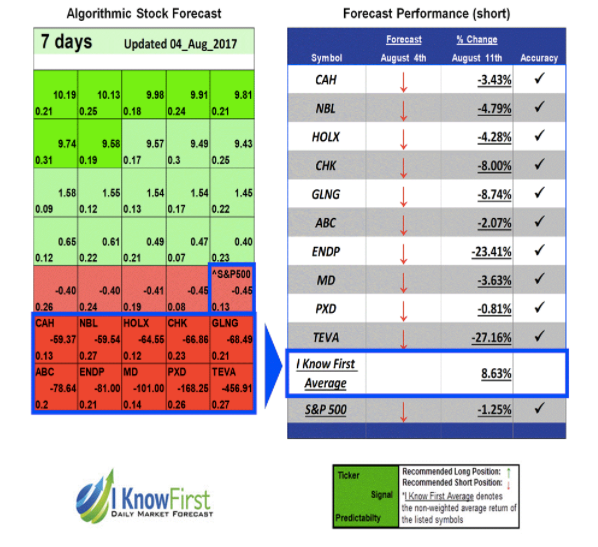TEVA Stock Forecast: Teva Announces Restructuring Plan After Shrank Of $57 Billion
 The article was written by Aline Rzetelna, a Financial Analyst at I Know First.
The article was written by Aline Rzetelna, a Financial Analyst at I Know First.
“You can make a lot of mistakes and still recover if you run an efficient operation. Or you can be brilliant and still go out of business if you’re too inefficient.” – Sam Walton
TEVA Stock Forecast
Summary:
- Why Teva Shrank By $57 billion In Two-And-A-Half Years
- Teva Announces Restructuring Plan
- I Know First Forecast for TEVA
Established in 1901, Teva Pharmaceuticals Industries Ltd develops, manufactures, markets, and distributes generic drugs and a portfolio of innovative and specialty medicines. The company is also the leading global supplier of active pharmaceutical ingredients. It has a portfolio of more than 1800 molecules, and produce approximately 120 billion tablets and capsules a year at 87 manufacturing facilities. Headquartered in Israel, TEVA is active in 80 countries worldwide.
Why Teva Shrank By $57 billion In Two-And-A-Half Years
On 2015, Teva made the decision to acquire Actavis Generics, the generics division of Irish drugmaker Allergan for $40.5 billion. Since then, Teva value shrank by 200 billion shekels ($57 billion) in only two-and-a-half years.
The then CEO, Erez Vigodman, believed that he would turn Teva into a generic giant with this merger. He was trying to overcome the loss of exclusivity over Copaxone, which generic rivals began to materialize, and also the declining prices of generics drugs in the United States.
But this acquisition seemed to be a hasty decision. Vigodman was trying to turn the company which is most known for the development of specialty drugs such as Copaxone, a medicine used for the treatment of people with relapsing forms of multiple sclerosis, into a company, which its primary business was focused on generic drugs. He has just forgotten that the business environment where TEVA is present is surrounded by the Israeli scientific and technology ecosystem that can build life science solutions to global health problems.
Therefore, after trying to change the main business focus of the pharmaceutical company, Teva landed in a not pleasant territory. The last financial results released by Teva did not show satisfying numbers.
The company, which is struggling under $35 billion of debt, saw its third quarter revenues ended September 30th, 2017, decreasing by $169 million in comparison to Q3 2016. Moreover, the GAAP operating income and non-GAAP operating income were also reduced by $32 million and $17 million, respectively.
Furthermore, GAAP gross profit went down 6% compared to the third quarter of 2016. GAAP gross profit margin, which was 50.4% in Q3 2016, decreased to 47.1% in the Q3 2017. Non-GAAP gross profit also declined 12% from 2016. The non-GAAP gross profit margin, which was 61% in the third quarter of 2016, decreased to 53% this year. This is a result of lower profitability of generic medicines and specialty medicines.
Finally, research and development expenses were also down 18% compared to the third quarter of 2016.
Teva Announces Restructuring Plan
On December 14, 2017, Teva announced a restructuring plan and additional measures to improve its business and financial performance. Teva’s current reality includes significant financial obligations in the coming 4 years, generic competition to the their largest branded product Copaxone and challeging environment in their largest generic market, the United States.
The company is, therefore, planning a turn around in the short/medium term by significantly reducing their cost base by $3 billion. This reductions will come from all elements of the cost base. Teva will cut more than 25% of the workforce (about 14,000 people) over the next two years. The savings are expected to allow the company to meet all of its financial commitments.
The rescue of the company include other few measures. First, the deployment of a new unified and simplified organizational structure (see image below). Second, the substantial optimization of the generics portfolio globally by discontinuing products that do not meet Teva’s new profitability benchmark, by downsizing the manufacturing, supply and R&D network and by adjusting the price of certain portfolio segments to better reflect current cost structure and market conditions.
Moreover, closures or divestments of a significant number of facilities and thorough review of all R&D programs across the entire company are also in the restructuring plan. Teva is expecting to optimize its cost base while protecting revenues and preserving core capabilities in generics and in select specialty assets, in order to secure long term growth.
In additional to this plan, Teva will also suspend immediately dividends payments on ordinary shares and ADRs, will continue to review additional divestment opportunities of non-core assets and will not pay annual bonus for 2017 in order to address the financial stability. The priority is to improve its financial profile through the stabilization of operating profit and cash flow.
I Know First Forecast on TEVA
After the news of the restructuring plan of TEVA, investors showed some confidence on Teva’s recovering path. Therefore, TEVA’s share price, reacted positively, increasing over the last month. The I Know First algorithm is showing a bullish forecast for TEVA in the short and medium term.
Although this short rebound, the I Know First algorithm has a bearish forecast for TEVA in the long term. It might be the case that the deal of acquisition of Actavis by Teva will destroy both of the companies. The restructuring plan of the recently hired CEO, Kare Schultz, is facing enormous opposition and might not last in the future.
Past I Know First Success with TEVA
On August 4th, 2017, I Know First sent to subscribers a bearish 7-day forecast for TEVA. In accordance with the forecast, TEVA stock price decreased 27.16%. The decrease in the share price is attributable to many reasons. Starting on August 3rd, Teva published a weak earnings report. Then Teva took a $6.1 billion write-down on its generics business, slashed its dividend 75% and announced thousands of layoffs. TEVA is also facing the risk of breaching its debt covenants, thanks to a $40 million hole it dug with a disastrous purchase of Allergan’s generics unit.
I Know First subscribers received this bearish forecast for TEVA on August 4th, 2017.
I Know First Algorithm Heatmap Explanation
The sign of the signal tells in which direction the asset price is expected to go (positive = to go up = Long, negative = to drop = Short position), the signal strength is related to the magnitude of the expected return and is used for ranking purposes of the investment opportunities.
Predictability is the actual fitness function being optimized every day, and can be simplified explained as the correlation based quality measure of the signal. This is a unique indicator of the I Know First algorithm. This allows users to separate and focus on the most predictable assets according to the algorithm. Ranging between -1 and 1, one should focus on predictability levels significantly above 0 in order to fill confident about/trust the signal.
To subscribe today and receive exclusive AI-based algorithmic predictions, click here.



















